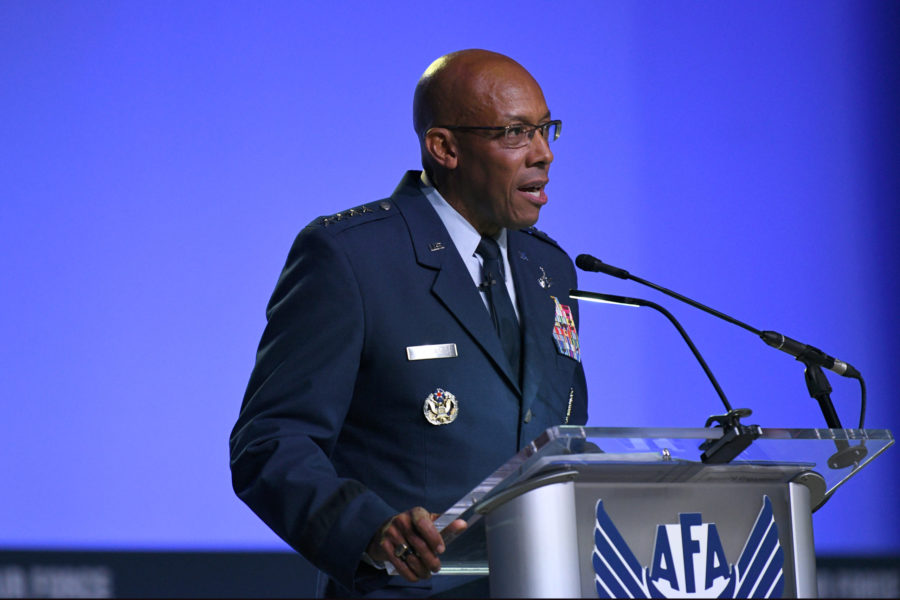The Air Force’s pilot production numbers stayed relatively steady from fiscal 2019 to 2020 despite the COVID-19 pandemic, Chief of Staff Gen. Charles Q. Brown Jr. said, an encouraging sign that the service’s efforts to speed up that pipeline are working.
“Our numbers didn’t really drop as far as production,” Brown said in a media roundtable at AFA’s Air, Space & Cyber Conference on Sept. 22. “In fact, they were really close, within about 10 or so. So that to me is a good indicator that we’re actually making some progress, even with COVID.”
In 2019, the Air Force produced 1,279 new pilots, according to a report from Air Force Times. In 2020, that number was 1,263, Stars & Stripes reported, with the number expected to increase by roughly 100 in 2021, Lt. Gen. Marshall B. “Brad” Webb said.
That progress could be especially key in the next few years. While the pandemic isn’t over yet, commercial airlines have expressed optimism about a rebound in travel and their long-term futures. Growth for those companies would mean more competition for pilots, which has caused shortages for the Air Force in the past—the pandemic provided a little relief on that front, with civilian jobs drying up and many pilots staying in the service. Indeed, United Airlines CEO Scott Kirby, who also spoke at the conference, has warned of a looming pilot shortage for both commercial industry and the military.
Part of solving the production issue, both Brown and Kirby said, will be providing opportunities for those who wouldn’t typically get the chance to ever train as a pilot. In the military, Brown said, that means changing the pilot candidate scoring mechanism so that private flying hours will only be rewarded up to 60 hours. On the commercial side, Kirby said United is taking a similar approach with its flight academy, looking to identify candidates with no flying experience.
“[Outside of the military], you kind of have to get your parents to spend $150,000 to get you enough hours to kind of get to the point where you can start the pilot [career path],” Kirby said. “There’s very few people who have the opportunity to do that.”
Approaches like that, the two men agreed, will be key for everyone.
“As the airline issue starts to open back up, that’ll be something we’ll have to continue to work on. And I think we have to work it as a nation, because this is a key skill set,” said Brown.
For the Air Force, the change to the scoring mechanism is just one of a raft of changes that Air Education and Training Command is making to address the racial disparity among its pilots, a disparity that limits the number of candidates. The other changes allow candidates to:
- Use their highest composite scores from any Air Force Officer Qualifying Test (AFOQT) rather than the most current score.
- Complete the Test of Basic Aviation Skills (TBAS) up to three times, with the third requiring a waiver.
- Re-take the AFOQT and TBAS after 90 days, instead of the 150 days previously required for the AFOQT and 180 days for the TBAS.
- Participate in study sessions with other individuals who haven’t taken the test if they have also never taken the AFOQT.
Brown also touted other initiatives and changes that the service has made in the past few months and years, among them Undergraduate Pilot Training 2.5 and Helicopter Training Next, aimed at reducing the amount of time the Air Force needs to train pilots.
The service is also looking to be more flexible in its training—civilian simulator instructors can now monitor the simulations remotely; students who are excelling now have the ability to graduate from pilot school early; and training courses can be tailored based on what skills students master fastest.
“Instead of having a kind of a road system that basically says, this is the same approach for every single candidate that comes through pilot training, [we’re] able to use some of the data and look at the ability. If you absolutely master a skill faster, … we can kind of tailor the training you get, so that by the end, you get everything you need. And that takes a little bit of artificial intelligence using data,” Brown said.
